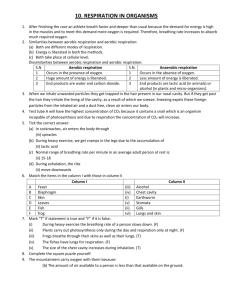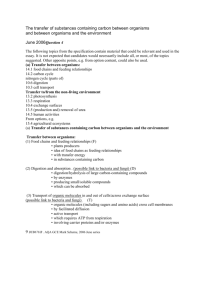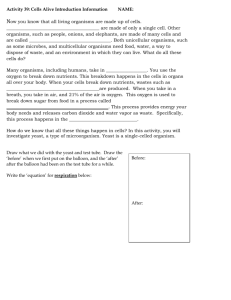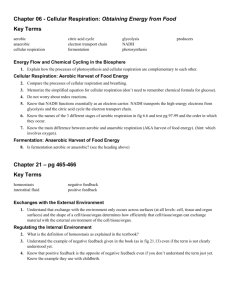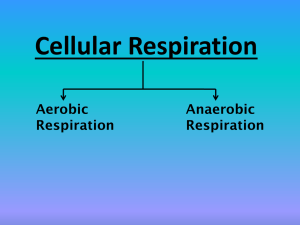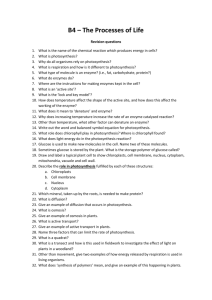f. Respiration
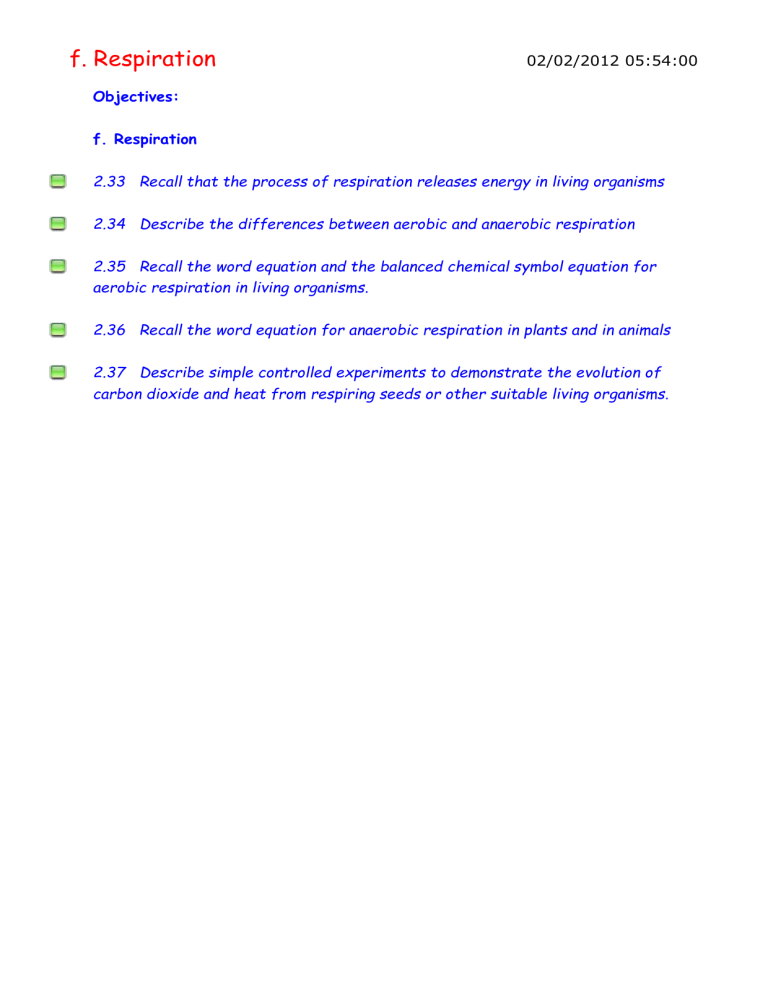
f. Respiration
02/02/2012 05:54:00
Objectives: f. Respiration
2.33
Recall that the process of respiration releases energy in living organisms
2.34
Describe the differences between aerobic and anaerobic respiration
2.35
Recall the word equation and the balanced chemical symbol equation for aerobic respiration in living organisms.
2.36
Recall the word equation for anaerobic respiration in plants and in animals
2.37
Describe simple controlled experiments to demonstrate the evolution of carbon dioxide and heat from respiring seeds or other suitable living organisms.
2.33 Energy Release
02/02/2012 05:54:00
2.33 Recall that the process of respiration releases energy in living organisms
Ref: Pg. 44 6.1 “Respiration releases energy from food”
Notes
Questions
1. What is the name of the process which takes place in living cells in your body and which releases energy from oxygen and glucose?
2. Name the two products of the process in question 1.
3. Complete the word equation for the process of aerobic respiration.
Glucose + ...........................
carbon dioxide + water
4. Which organ removes carbon dioxide from your body?
5. The graph shows the amount of oxygen used by animal P at different air temperatures.
(a) Describe the relationship between the amount of oxygen used and temperature. (2)
(b) Explain why most oxygen is used at the lowest air temperature. (3)
2.34 Aerobic vs Anaerobic
02/02/2012 05:54:00
2.34 Describe the differences between aerobic and anaerobic respiration
Ref: Pg. 45
Notes
6.3 “Respiration sometimes occurs without oxygen”
Questions
1. The air you breathe in and the air you breathe out are different.
Use the names of gases from this box to complete the three spaces. argon carbon dioxide nitrogen oxygen vapour water
Compared to the air you breathe in, the air you breathe out contains: (3)
more .....................................................................................................................
more .....................................................................................................................
less ........................................................................................................................
2. During races, athletes get energy from both aerobic and anaerobic respiration. The table shows the percentage of energy from aerobic and anaerobic respiration in races of different length.
(a) What percentage of energy is provided by anaerobic respiration in a 10 000 m race? (1)
(b) In how many of the races does aerobic respiration provide a greater percentage of energy? (1)
(c) Use words from the box to complete the passage. (4) carbon dioxide energy glucose
lactic acid oxygen water
Aerobic respiration uses ........................................................
and
...........................................................
to produce a lot of energy. The two waste products are .........................................................
and ........................................................
2.35 Aerobic Respiration Equation
02/02/2012 05:54:00
2.35 Recall the word equation and the balanced chemical symbol equation for aerobic respiration in living organisms.
Ref: Pg. 44 6.2 “Respiration oxidizes sugars in stages”
Notes
Questions
1. The drawing shows a herbivore being killed by a snake.
The snake kills the herbivore by stopping it breathing.
Explain why the herbivore dies if it cannot breathe. (3)
2.36 Anaerobic Respiration Questions
02/02/2012 05:54:00
2.36 Recall the word equation for anaerobic respiration in plants and in animals
Ref: pg. 45 6.3 “Respiration sometimes occurs without oxygen”
Notes
Table 6.1 “A Comparison of aerobic and anaerobic respiration” pg. 45
Aerobic Anaerobic
Questions
1. Use names from the box to complete the two spaces in the passage. carbon dioxide lactic acid nitrogen oxygen water
Anaerobic respiration can occur when an athlete does vigorous exercise.
This is because there is not enough .......................................................
in the body.
The product of anaerobic respiration is .................................................................
.
2. An athlete sprints a 100 metre race in 10 seconds, then rests.
Respiration in leg muscles during a sprint race is mostly anaerobic.
(a) What is meant by the term anaerobic respiration? (1)
(b) Explain why lactic acid concentration in the blood of the athlete
(i) rises during the race (1)
(ii) falls after the race (3)
2.37 Respiration Experiments
02/02/2012 05:54:00
2.37 Describe simple controlled experiments to demonstrate the evolution of carbon dioxide and heat from respiring seeds or other suitable living organisms.
Ref: pg. 44 Practical 6.1 “To show that peanuts release energy when
they are oxidized”
pg. 45 Practical 6.2 “To show that heat is produced in respiration”
Notes
pg. 46 Practical 6.3 “To show that carbon dioxide is produced when
yeast respires anaerobically”
Questions
1. The athlete is taking part in vigorous exercise.
(a) Complete the two spaces in the passage.
The cells in our muscles respire anaerobically during vigorous exercise. This results in ........................................
debt and the production of .......................................
acid.
(b) Explain, as fully as you can, why respiration has to take place more rapidly during exercise.
2. This apparatus was used to measure the effect of temperature on the respiration rate of mealworms.
(a) Name the gas absorbed by sodium hydroxide solution. (1)
(b) Show on the diagram the direction of movement of the water drop. (1)
(c) Give one difference between the apparatus shown and a suitable control apparatus. (1)
3. The rate of respiration was measured at intervals from 20 °C to 50 °C. The graph shows the results of the investigation.
(a) Explain the results shown on the graph. (2)
(b) What was the rate of respiration at 37 °C? (1)
(c) Suggest what would happen if temperatures above 50 °C were used.
Give a reason for your answer. (2)

